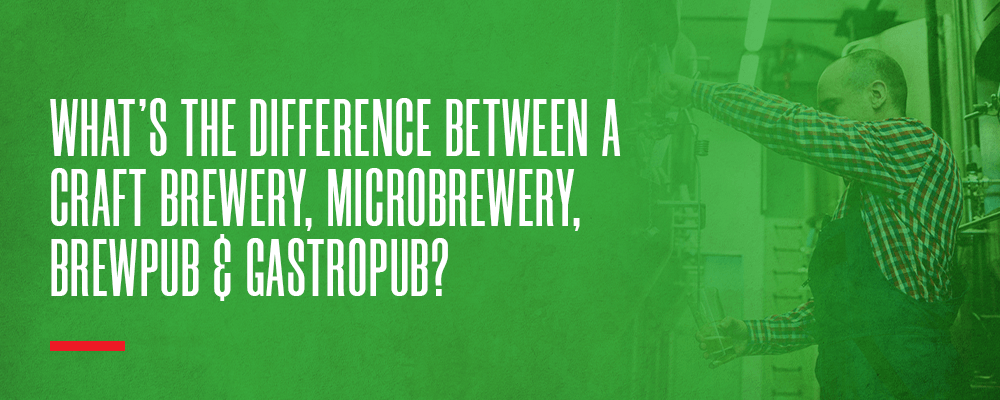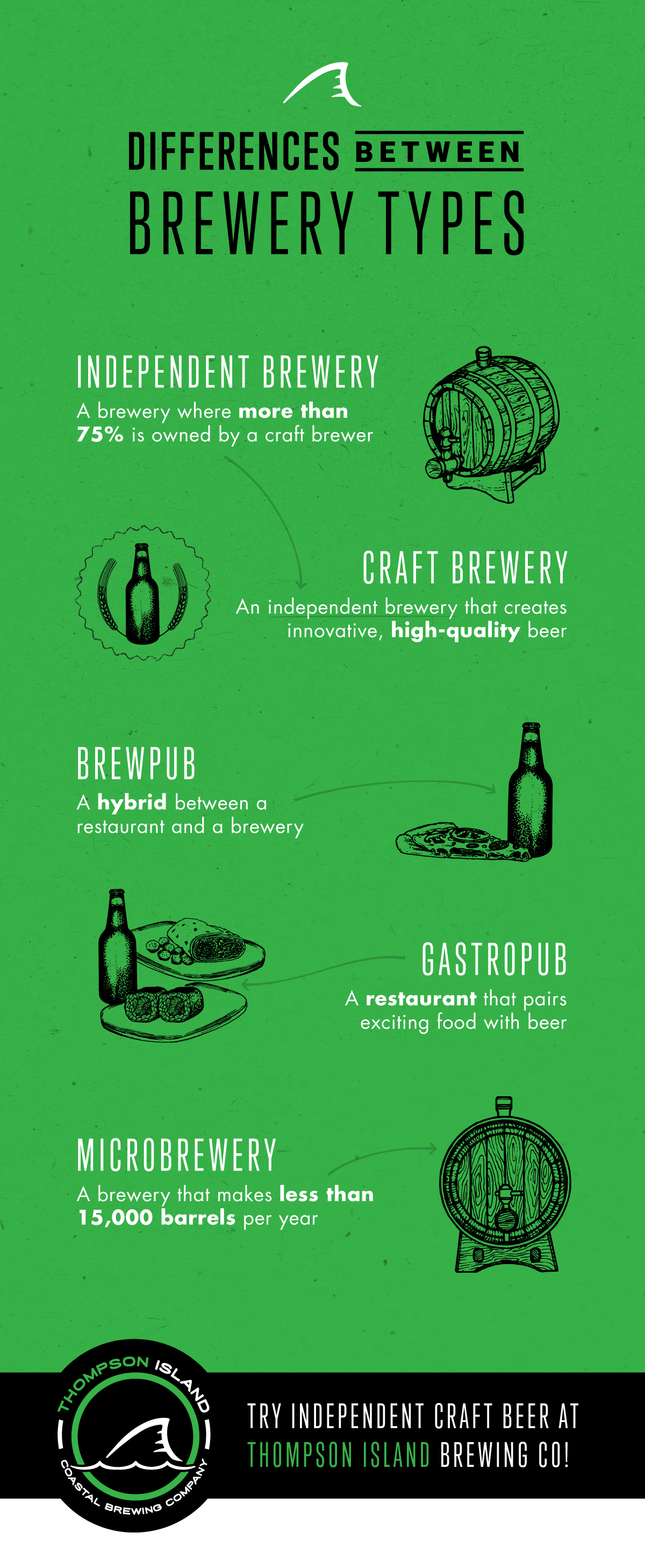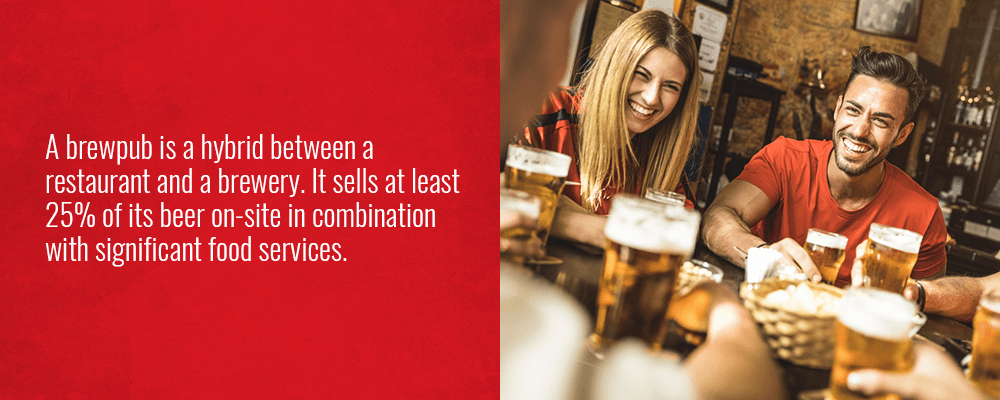What's the Difference Between a Craft Brewery, Microbrewery, Brewpub & Gastropub?
When you go to a bar or restaurant with a brewery in it, a lot is going on behind the scenes that you might not realize is happening. Depending on whether the establishment is a craft brewery, microbrewery, brewpub or gastropub, it has certain characteristics that help define the type of experience you'll have there. Throughout the rich history of pubs, taverns and bars, changes and updates have created new environments in which to enjoy a brew. We'll take a look at some of that history and help you understand the difference between the multiple types of breweries and pubs that have arisen over the past several decades.
A Brief History of Pubs
Pubs have been a central social cornerstone in European culture since the time of the Romans. These community gathering spaces allowed and encouraged locals to get together and often discuss public events — thus the term "public house." They weren't always having hard-hitting conversations, however. Many people would just sit and pass the time. The thing that separated pubs from the cafes of the time was the focus on beer and wine rather than coffee or tea. However, many pub owners capitalized on their location by operating adjacent shops where people could buy general goods.
A significant portion of Europe's oldest alcoholic beverage companies were first the in-house brand of a small pub, as they began to offer specialized beverages. The focus on beverages often meant that early pubs only had a minuscule variety of food offerings, termed "pub fare." At first, some of our favorite dishes, like fish and chips, started as cheap options for working-class pub patrons.
Pub history in the United States continued to evolve along similar lines. Pubs in early America were not fancy establishments with menus full of drinks and dishes. They were simply a place for people of all stations and circumstances to gather and converse on an equal playing field.
The rise of industry produced increased immigration in the 1800s, leading to great diversification in the ingredients available to breweries. With more available ingredients, brewers shifted the American drinking culture to accommodate a much broader range of tastes. Pub patrons were suddenly able to experience a wider range of brews and drinks, such as the Sazerac, which is thought to have been created in New Orleans.
America's taste for beer and breweries has remained steady. Today, about 63% of adults drink alcohol, with 42% of them preferring beer. In recent years, the number of options beer drinkers have for enjoying their favorite beverage is higher than ever.
Categorical Differences Between Types of Breweries
There are a few ways to categorize breweries, including by differentiating them based on the production amount. These are some of the categoriese to know when it comes to breweries.
What is a Microbrewery
A microbrewery is a brewery that produces 15,000 barrels or less of beer per year. They must also sell 75% or more of that beer in off-site locations, although some microbreweries have small tasting rooms or a bar for visiting consumers. Microbreweries complete their sales in one of these three ways:
Three-tier system: The brewer sells to a wholesaler who sells to a retailer who sells to the consumer.
Two-tier system: The brewer acts as a wholesaler and sells to the retailer who sells to the consumer.
Direct sales: The brewer sells directly to the consumer via carry-outs or sales from an on-site taproom or restaurant.
What is a Brewpub
A brewpub is a hybrid between a restaurant and a brewery. It sells at least 25% of its beer on-site in combination with significant food services. At a brewpub, the beer is primarily brewed for sale inside the restaurant or bar. Where it's legally allowed, brewpubs may sell beer to go or distribute it to some offsite destinations.
What is a Taproom
A taproom brewery is similar to a brewpub in that it sells 25% or more of its beer on-site. The main difference is that there are few if any food services. In taprooms, the experience is all about the beer itself. Like brewpubs, a taproom may sell to-go beer and perform distributions off-site.
What is a Regional Brewery
A regional brewery fits in one of the broader categories. According to the Brewers Association, a regional brewery produces 15,000 to 6,000,000 barrels of beer annually.
What Is an Independent Brewery?
The most basic identifier to know when it comes to breweries is whether or not they are independent. In an independent brewery, less than 25% of the company is controlled or owned by an alcohol industry member that does not qualify as a craft brewer. There have been a few changes to the benchmark of what defines small breweries vs. large breweries, which altered the definition of what it means to be independent. In 2010, the Brewers Association changed the definition of "small" from a maximum of 2 million barrels to 6 million.
The Brewers Association decided to shake things up again in 2017, by creating the Independent Craft Brewer Seal to identify the breweries who fit the craft brewer definition. Part of this definition is that the brewery be independent, making this a crucial factor in whether a brewery can call itself "craft" or not. As of 2019, more than 4,000 craft brewers are using the seal to differentiate themselves and highlight their quality. This group represents more than 85% of the volume of craft beer produced in the United States. The seal is one way brewers have hit back at the Anheuser-Busch company, which has bought out 10 independent breweries since 2011.
What Is a Craft Brewery?
A craft brewery is, by definition, an independent brewery. Breweries of this scale produce far smaller amounts of beer as compared to their large-scale corporate counterparts. The term "craft" has to do with the fact that these breweries emphasize quality beer and tend to view beer production as more of an art form driven by passion and finely-honed techniques. In both the United States and the United Kingdom, the craft brewing movement started to gain momentum in the 1970s despite artisanal brewing having existed for centuries in Europe. Here are some crucial characteristics of craft breweries:
Craft brewers are small and independent, without substantial guidance from any non-craft brewer.
The hallmark of a craft brewery is innovation.
Craft brewers provide new interpretations of historical styles as well as new, unprecedented styles of beer.
Craft brews are made with traditional ingredients as a base, and often include non-traditional ingredients that provide distinction.
Craft brewers are often closely involved in local communities, providing philanthropy, donations, volunteers and event sponsorships.
Craft brewers often like to connect with their customers in an individualistic and distinct manner.
Craft breweries are everywhere. Almost 79% of American adults live within 10 miles of a brewery, with the majority of them being craft breweries. There are some misconceptions about craft breweries that are important to clear up. The most pervasive one is likely that craft beers are all powerfully distinct and possibly overwhelming in flavor. This is certainly the case for many craft brews, as the popularity of different high-alcohol IPAs proves, but craft brewing also affords brewers the opportunity to experiment with milder tastes and a lower alcohol content.
Many people believe you can always distinguish a craft beer from one produced by a macrobrewery, with the latter having a weaker and more bland flavor. There's no true way to identify a craft beer besides looking into the brewery that created it, but there are a few differences that make craft beer stand out in a positive light.
Appearance: You may have noticed that mass-produced beers are often the same shade of watery yellow, and the head dissolves away quite quickly when you pour into a glass. Craft beers come in an astonishing array of colors that depend on the brew, and their heads look better, last longer and provide a better flavor.
Taste: Because mass-produced beers must maintain homogeneity, they are often very flat and bland in flavor — which is why they are served as cold as possible. Craft beer has more nuanced flavors that typically come out at warmer temperatures.
Production: Macrobrewers are in it for the money, and it shows in the cheaper ingredients they use to lower the cost of production as well as the finished product. Where many macrobrewers used to use traditional hops, they now substitute rice or corn as a cost-cutting method.
Craft breweries are defined by their commitment to quality ingredients, both novel and traditional, and brewing techniques that are designed to maximize flavor and aroma rather than profit.
What Is a Brewpub?
In states where brewers can sell their product directly to consumers without a middleman, they can establish what's known as a brewpub. The brewpub definition is a combination of a brewery and bar, where the beer served comes directly from the brewery. An establishment can only be designated a brewpub if 25% or more of its beer is sold onsite.
Brewpubs have the unique advantage of dispensing beer straight from the brewery's storage tanks. These large tanks are often used as an aesthetic cornerstone for the establishment, as they undeniably have an industrial visual appeal. The presence of the storage tanks also provides an atmosphere of authenticity that many consumers appreciate when embracing the spirit of craft brewing. The setup of a brewpub often showcases the way the beer is brewed as well as the technical skill required to produce a quality beverage.
Where legal, many brewpubs operate to-go services with growlers and do some distribution to off-site locations to build their brand.
What Is a Gastropub?
Gastropubs are the newest iteration on the tried and true tavern and public house. The difference between a gastropub vs brewpub is the focus on food. The moniker comes from adding "gastronomy," the practice or art of cooking and eating quality food, to the familiar scene of the pub. This trend began in the 1980s and 90s, as "foodie" culture began to take hold in earnest. Pubs began to realize that if people would flock to a brewery for a unique beer experience, they might also enjoy pairing it with a unique food experience.
The first authentic, self-declared gastropub was The Eagle in London, which debuted in 1991. Rather than the mundane menu of fried foods and less-than-exceptional service English pubs are known for, the Eagle presented a novel and exciting experience combining innovative food with quality brews.
While England enjoyed the gastropub and the establishments began popping up in Europe, the craze didn't hit the United States until 2004 with the opening of the Spotted Pig in New York City's West Village. Its resounding success caused a slew of others to spring up around the city soon after, and now you can find a great gastropub in any metropolitan area.
What Is a Microbrewery?
Where do microbreweries fit into all of this? The microbrewery definition is simple. A microbrewery makes less than 15,000 barrels of beer each year, and 75% or more of it must be served off-site. The term is unfortunately unclear to many, with people often using "microbrewery" to refer to any business that brews craft beer. The only difference between a craft brewery and a microbrewery is volume. A craft brewery doesn't necessarily indicate a microbrewery, although many microbreweries do brew craft beer. Likewise, a microbrewery does still have to meet craft brewing standards to be a craft brewery.
There is also the term "nanobrewery," which is similar to the definition of a microbrewery in terms of focusing on craft beer. However, there is no specific production volume or limit for a nanobrewery. In general, the term is used to refer to a brewery run by just one or two brewers. Like microbreweries, nanobreweries can sell their beer in a three-tier, two-tier or direct sale structure.
These terms can also be used in combination with other terms. For instance, you would not be in the wrong to refer to the brewing section of a brewpub as a microbrewery as long as you actually know how much volume the brewer produces.
Benefits of Microbreweries
Microbreweries make beer on a small scale, and this smaller production volume creates distinct advantages for the drinks' quality and variety. These breweries can also help their surrounding communities. A few benefits of microbreweries include:
Super taste: When brewers create a beer in smaller amounts, they have room to focus on flavor and refine the brewing process to create the best combinations. They can also try out new flavors in smaller quantities for greater variety to fit changing seasons.
Good ingredients: Rather than focusing on a mass-produced product, microbreweries often thoughtfully choose high-quality components that can even offer health benefits like antioxidants. This quality is most prevalent in craft microbreweries.
High alcohol content: Mass-produced beer often has a high water content, making the alcohol content relatively low. Microbreweries avoid these shortcuts and gain a high alcohol content.
Passionate work: These breweries focus on quality over quantity, so though they sell in smaller batches, each batch will show the brewer's dedication.
Environmental protection: Ingredients used for microbrews often come from local sources. Many microbreweries also focus on environmental stewardship through water conservation and other sustainable practices.
Economic impact: When microbreweries sell their products to the surrounding area, they can increase local tourism. Some of these breweries also use locally grown ingredients, which funnels money back into the economy.
Brewers that produce beer at a larger scale sacrifice quality and ingenuity, leading to a basic product that rarely changes. People looking for new flavors or a creative twist on their favorite brew often turn to microbreweries. This interest in innovation leads to smaller, local breweries thriving and shaping the beer brewing industry.
Microbreweries can even encourage beer lovers to engage in the craft. It may seem difficult to compete with macrobreweries, but microbreweries show that bigger isn't always better. Beer lovers might gain encouragement from microbreweries and begin to brew their own unique drinks, leading to a more diverse industry with exciting flavor combinations.
Microbrewery Economic Impact
Given the relatively small beer quantities produced by microbreweries, some might wonder about their importance. One of the most influential things microbreweries can do is to boost their local economy. While macrobreweries operate on a nationwide or global scale, microbreweries create a small volume of beer and often sell to local wholesalers or retailers.
People who buy microbrews help the local economy. In turn, microbreweries often contribute to charities or outreach in the area to show their gratitude for community support. Some microbrewers even source ingredients from local farmers, helping support smaller businesses rather than corporate food growers.
Microbreweries also serve as attractions that can increase local tourism. Some microbreweries offer tours or tastings, and others become famous as local staples. These breweries may inspire visitors to stop by area retailers to check out new seasonal flavors or try the brand everybody raves about.
These breweries also help the economy and tourism by helping one another succeed. Rather than competing for business, many microbreweries in nearby geographic areas help one another grow. A network of successful microbreweries in an area can create a draw to a region, as visitors and local customers travel to taste the unique brews each business offers.
Thompson Island Brewing Co.
Thompson Island Brewing Company is an independent craft brewery and restaurant that celebrates the coastal Delaware lifestyle with style and passion. Our craft beer is made by brewers who aren't afraid to try new and bold brews and serve them right alongside high-quality traditional recipes. Our offerings range from strong IPAs to smooth blonde ales and everything in between, and we offer a selection of rotating guest taps to expand your options.
Whether you want to gather with friends and enjoy drinks and a game or delve into our revolving menu of seasonal offerings, you'll do so in a friendly and fun atmosphere. With a dining room, bar, porch and beer garden, you'll find the setting that best suits your mood. When you're looking for a combination of quality craft beer and a delicious meal, Thompson Island Brewing is the place to be.






